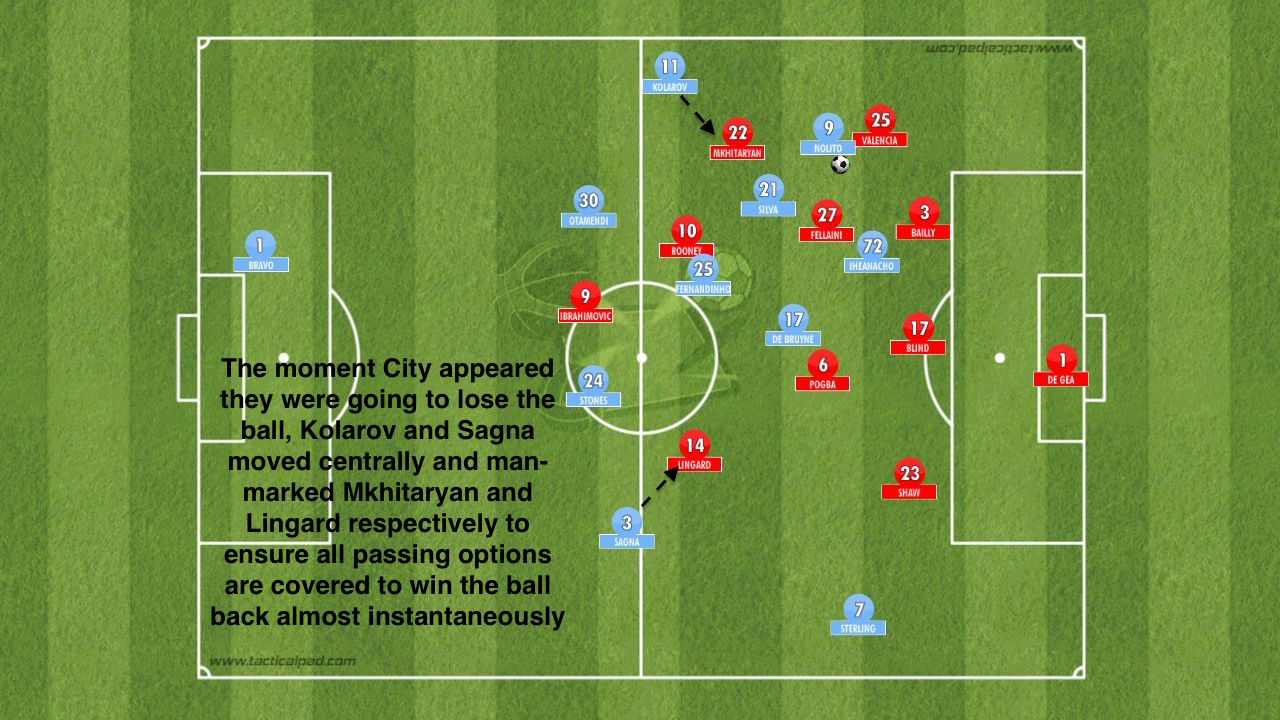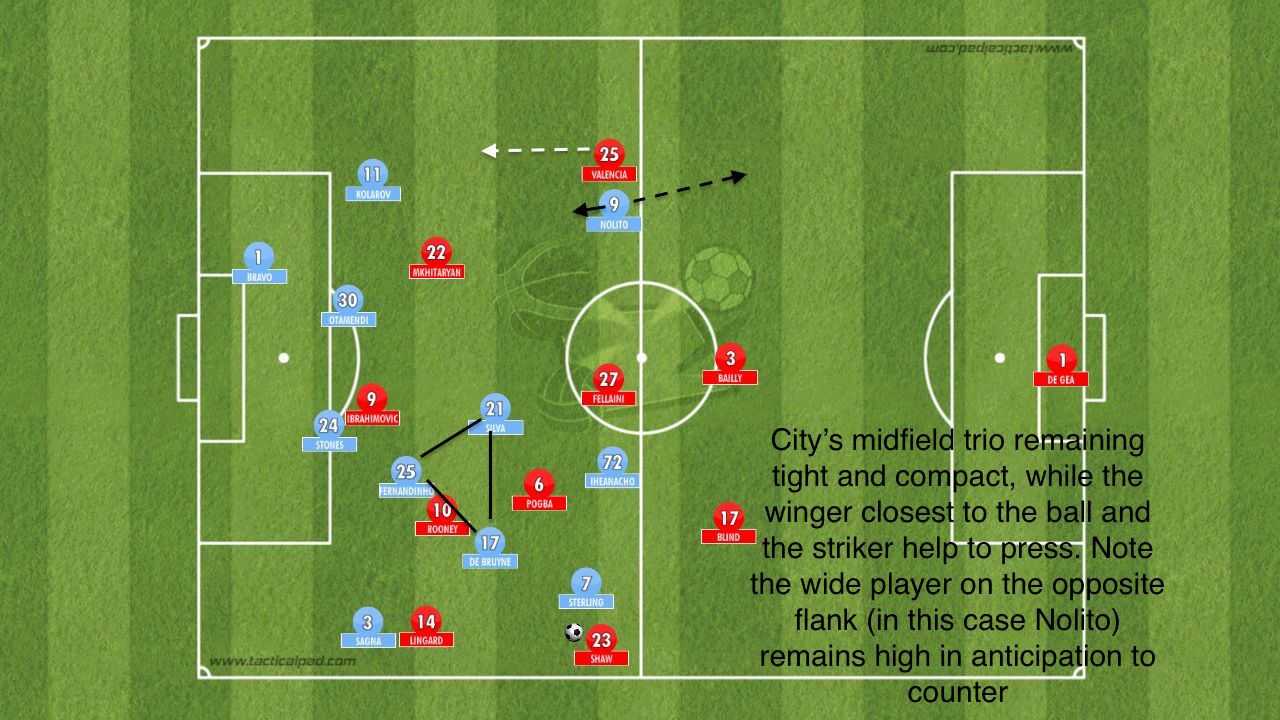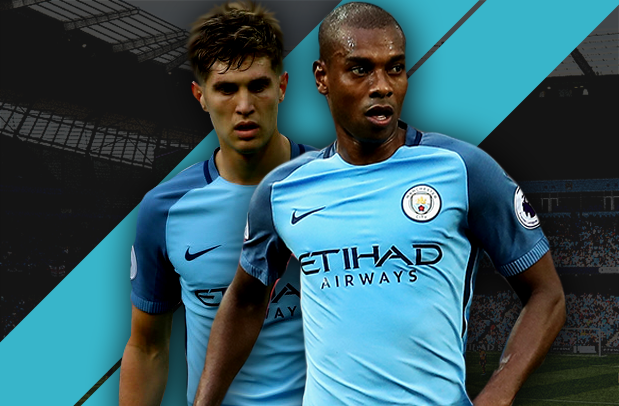Pep Guardiola and Manchester City stole the show this past weekend with a scintillating performance in the first half. Daniel Wong tells us what happened.
On Saturday, Josep Guardiola’s Manchester City defeated Jose Mourinho’s Manchester United 2-1, in one of the most built up Manchester Derbies in recent memory. Manchester City’s impressive first-half performance was enough to win them the match, although several goalkeeping blunders from the debutant Bravo kept United in the game. This article will look at why Manchester City was so dominant in the first half.

Manchester City Finds the Right Balance Between Attack and Defence
Pep opted for a 4-3-3 on Saturday, micro-managing several players to give the formation more freedom. Furthermore, he showed one thing he wasn’t afraid of doing after changing his style of play at Bayern: playing more direct. Pep has set up his team to operate in two units with respective roles. The defensive roles were to recycle possession and play long or penetrating passes (Sagna, Stones, Otamendi, Kolarov, Fernandinho, and Silva), and the attacking roles were to search for and create space to give options when these passes came (Nolito, Iheanacho, De Bruyne, and Sterling).

Fernandinho and Stones would regularly swap positions, with Fernandinho sometimes joining the centre-backs to form a back 3 in possession. This was done to ensure that they had time to play the ball in either a penetrating manner, or to recycle possession, which was possible through their creation of triangles. Silva would come back to recycle possession and drop in between spaces in the central midfield to do so. The role of Silva and the back three was to recycle possession until they could play penetrating passes into their forward players.

De Bruyne on the other hand went further forward, creating essentially a front 4 between him, Iheanacho, and the 2 wide players. True to a typical Guardiola team, City’s wide players would trust their positions and stay as wide as possible until they could create specific situations – an overload particularly on the left hand side, or to recycle possession. When the ball was on the opposite side of each wide player’s respective side, they would stay as wide as possible. Raheem Sterling would do this the most in an attempt to create a 1v1 against Shaw once the ball was switched over to his side. Nolito on the other hand, would come slightly deeper and more on the inside to receive the ball. Furthermore, the front four made the pitch wide and stretched, which allowed City to build with possession and penetrating passes once spaces opened up, or to send the ball in a direct manner if need be. This forced United to cautiously press the City defenders, as doing so might give the City attackers too much space in great positions should the ball come to them. For De Bruyne’s goal, this was the case. City had run out of space passing it around the back due to a high United press, but their front four were in high positions. Once the ball was sent long into Iheanacho by Kolarov, he flicks it onto De Bruyne who opened up the scoring with a great finish.

City’s full backs operated in polar opposites: while Sagna was given a more disciplined role, Kolarov was given a more advanced role, regularly getting forward. Despite all the pre-match build up regarding Guardiola’s usage off inverted wing-backs, Kolarov and Sagna rarely ventured too centrally. Instead, it appears that Guardiola has asked them to man-mark their wide men once it appeared like Manchester City might lose the ball. Naturally, when United was defending, their outfield players (notably Mkhitaryan and Lingard) would come closer to their midfielders to narrow down City’s playing spaces. It was in these moments that Kolarov and Sagna would drift centrally in order to prevent counter-attacks and win back the ball straight after a United transition. Combined with the aggressive challenges coming from their forwards and midfielders, City was able to quickly win back possession and counter-transition.



This setup tested the home side’s decision making, and it showed. City’s movement resulted in most of their attacks coming on the left and the centre. When City had possession with Stones, Otamendi, and Fernandinho, players like Nolito, Iheanacho, Sterling, and De Bruyne would move further forward and make the field as wide as possible. Nolito would then move slightly inside and deeper to receive the ball to draw out Valencia, while Silva would support the play to recycle possession. This created an overload via Kolarov, forcing Valencia, Bailly/Blind, and Fellaini to make the decision to either follow their man, or to let them receive possession. Furthermore, as United only focussed on pressing Stones and Fernandinho via Rooney and Ibrahimovic, the penetrating passes into the front four still came, albeit from Otamendi, who was allowed to carry the ball further up the pitch. City also exploited the width that their front four gave them, constantly switching the play to Nolito and Sterling. In one passage, in just several seconds, the ball was switched to Sterling’s side, recycled back to the midfield, and switched to Nolito’s side. This game-plan allowed City to create a number of chances in the first half, and look threatening all match.

The quick manner in which City got the ball forward into attacking spaces after winning possession reminded me of Barcelona vs Real Madrid back in 2009. Without the ball, City looked more like a 4-3-3. De Bruyne, Silva, and Fernandinho would stick close together, with Silva or De Bruyne initiating aggressive pressure to trigger the rest of the team to press. The most interesting thing to note was the role of City’s wide players. When the ball was on their respective side, they would sprint back to help press. However, the player on the opposite flank would drop only slightly unless the ball was switched over to their side, for which the above would remain true. In doing so, once City won the ball back, the midfield had the option to play short combinations in the midfield to reset possession, or look forward immediately with options given to them by Iheanacho, other midfielders, and the furthest wide player. As City aggressively threw themselves into tackles to regain possession, this occurred many times, which created more goal-scoring opportunities, as well as fatiguing the Manchester United players, who had to sprint back to help their defenders.

Lack of Discipline from United
As much as one can praise Manchester City, one can criticize Manchester United for their lack of discipline and early team shape. The first criticism starts with the team shape – United played a 4-2-3-1, and were completely overrun by the three in City’s midfield. To make things worse, at times it seemed United were playing with one midfielder, with Fellaini looking isolated when defending. Pogba was too undisciplined and aggressive in the first half considering he was one of the two central midfielders in the setup, which left massive gaps of space in the midfield for City to pass through United. It didn’t help that Lingard and Mkhitaryan seemed to be bystanders before their substitutions. Once these gaps were exploited, Mourinho’s men had to run back from their advanced positions, which took its toll as evident halfway through the second half. Mourinho noticed this and subsequently changed to three in the midfield and opting for a more direct approach, with Fellaini, Pogba, and Ibrahimovic all moving into advanced positions while Herrera would play the holding role. Unfortunately for United, it was too late and City kept their first half lead until the very end giving them a famous victory.
Another instance of lack of discipline came from United’s eagerness to press City when they were passing the ball around the back when the rest of their team weren’t in positions to continue their press. An example of this was seen in the build-up for Iheanacho’s goal. Pogba, Ibrahimovic, and Lingard have pressed high up on City’s right hand side. Under pressure, it was obvious what City were going to do – pass the ball around the back to the other side. Because Pogba had already went to City’s right hand side, the 2 man midfield became a one man midfield. Seeing this, Mkhitaryan and United should have decided that the press was no longer on due to the massive gaps of space. Instead, Mkhitaryan goes wide to City’s left to continue the press, leaving Fellaini all alone. The ball is played through the midfield space, and then quickly to the flank. With United’s players hustling back to the City left to pressure the ball again, Sterling and Sagna are given too much space. The ball was rightfully switched to their flank, and after some brilliant movement from De Bruyne and a bit of luck, City was able to score their second of the game.



Conclusion
Barring the erratic display from Bravo that Simon Mignolet would be proud of, Saturday’s derby was a masterclass from Manchester City, masterminded by their manager who saw his team do almost everything right in the first half. Mourinho on the other hand will have had lots to think about – whether to play Pogba in a midfield three, whether to play with two mainly defensive midfielders, and more. United certainly looked more threatening with the electrifying and direct Marcus Rashford, as well as having the options to send the ball long with the security offered by Herrera, and the height from Ibrahimovic, Pogba, and Fellaini. Time will tell whether any of this will be the case in the next derby.
- Tactical Analysis: Liverpool 4-0 Arsenal | Klopp Exposes Wenger’s Stubbornness - September 2, 2017
- Analysis: How Manchester City found the right balance between Attack and Defence against Manchester United - September 16, 2016
- Euro 2016 Tactical Analysis: France 0-1 Portugal (AET) | Substitutions the key for Portugal - July 14, 2016



























































